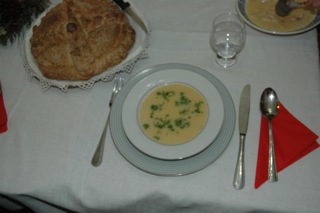GREECE
Contributors: Antonia Matalas and Ellen Matalas
Christmas Food Customs in Greece: *
The period, which starts on Christmas Eve, December 24th, and ends with Epiphany, January 6th, is called by the Greeks the δωδεκαήμερον(dodecahemeron) -- which means twelve days. The dodecahemeron represents a period not only of celebration, but also of tribute to the family members and others who have passed away. A ceremonial bread, the Χριστόψωμο, (Christopsomo - Christ's bread), is prepared on Christmas Eve; in some regions pieces of Christopsomo were distributed to the poor on Christmas Day in memory of the dead.
Photograph (c)2008 Antonia Matalas
This picture shows the Christopsomo in top left of the picture
and egg-lemon soup in the centre.
Christmas marks the end of a 30-day fast, i.e. a period of abstinence from all animal products. During the celebrations of the dodecahemeron which follow this fast, the table of the Greeks is dominated by meat and its products. Traditional dishes, characteristic of Christmas, are pork with celery, roasted pork, pork sausages, and the egg-lemon soup. Pork, in particular, has a special relationship with Christmas: in many Greek regions, Christmas Eve or Christmas Day was the day for the household pig to be slaughtered. The χοιροσφάγια(cherosphayia), as this ritual slaughter of a pig is called in Greek, holds its roots in antiquity, and in past decades it represented an important food tradition. Cuts of fresh meat, the liver and other organs were typically barbecued in the fireplace and eaten right away. Over the next few days, several products were prepared from this pork meat, such as sausages, σύγκλινο (seglino - smoked pieces of fatty meat preserved either in pork fat or in olive oil), λούντζα (lountza - a type of smoked ham), pork jelly, and pieces of pork fat, that were salted andsaved to be consumed throughout the year.
A festive cake is baked to celebrate the Orthodox feast of St. Basil and to welcome in the New Year, a custom that can be traced back to at least the 1850s. Within this cake, βασιλόπιττα (vasilopitta - St. Basil's bread) a coin is hidden, preferably a gold or silver one. The vasilopitta is 'ceremonially' sliced on New Year's Eve and the pieces are distributed by the head of the household to the members of the family and participating friends. Whoever gets the piece with the coin is said to be lucky for the forthcoming year.
* (c)Copyright 2008 Antonia Matalas, Helen Macbeth. Permission is hereby granted to reproduce and distribute copies of this Introduction to recipes for Greece solely for the purposes of non-profit domestic use or non-profit educational purposes in either case provided that copies are distributed at or below cost and that the author's source and copyright notice are included on each copy.
